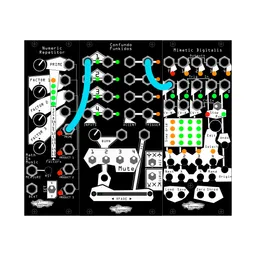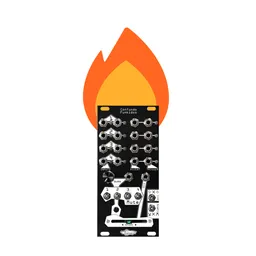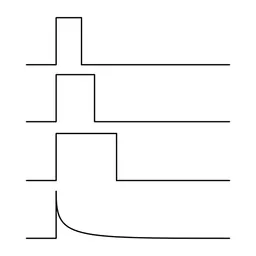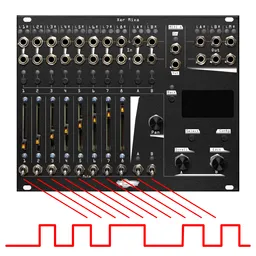A long time ago in a blog post far, far away we explored the concept of using gate signals as CV modulation. Today, we’ll expand on that concept using some extra utilities to create surprisingly complex results.
Attenuated gates and mults to make CV
Rhythmic parameter changes are a useful and simple way to bring musical interest to a patch. I have a number of gate sequencers in my system (Bin Seq is a longtime favorite for this type of patch) and running the output through an attenuator is a great way to make controlled changes in a patch. By multing the output into multiple attenuators, we can modulate multiple CV destinations by different amounts at the same time, too. In one of my current patches, I have a Bin Seq dedicated to accents on my drums: the gate signal runs into Sinc Defero, which acts as both a mult and an attenuator and creates four attenuated copies of the incoming signal. The output goes to different CV ins on my drums. This makes it easy to, for instance, make kicks at the beginning of a measure decay longer, or increase the amount of distortion on some snare hits.

Clock dividers: they’re not just for clocks anymore (because they can make CV)
If the CV signal I want to create follows a standard clock pattern (for instance high for half a measure then low), I’ll sometimes use an attenuated clock divider instead of a gate sequencer for simplicity. We can follow the same patch as above with a mult and attenuators — I find that long divisions like /64 and /128 can be especially useful for changes in a long-form patch.
We can make things even more interesting with some extra utilities, too: if you have a logic module with an inversion utility you can mult your clock divider to it and create alternating CV signals that can be used for counterpoint in a patch. For example, if you have two melodic voices, you can use these two signals to change the timbre of each by modulating things like filters and wavefolders, or the envelope time to emphasize the voices at different times.

Another useful utility for this sort of modulation is the slew: especially on long clock divisions, using a slew to increase the rise and fall time of the gate-turned-CV signal is a great way to make things sound more natural.
Using CV mixers for multistage CV sequencing
This technique is a personal favorite of mine. Recently I had a patch where I wanted a simple way to change the position of a four-channel sequential switch in an irregular way with CV. This can be done with two gate sequencers and a CV mixer: by attenuating one gate sequencer more than the other and mixing their outputs together, it’s possible to create a CV sequence with four different output values (both gates low, gate 1 high, gate 2 high, or both gates high). This is useful not only as a way to create CV signals from non-CV sequencers, but it’s incredibly easy to modify the resulting CV sequence on the fly with the flick of a few switches on a gate sequencer like Bin Seq.







